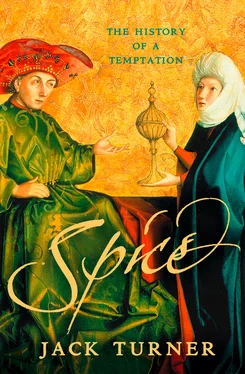1 ...6 7 8 10 11 12 ...26 For those who profited thereby da Gama’s arrival represented an almighty spanner in the works; for the Portuguese, a coup de théâtre. Now for the encore. Surviving the voyage out was one thing, but the Portuguese had still to find their way through the perilous shoals of Malabar politics, in which respect they were utterly in the dark. It seems that da Gama had expected to find in India a situation similar to that the Portuguese knew from their trading voyages to West Africa, where they could barter trinkets of low value for stellar returns, and so was taken aback to find the rich and sophisticated Indians demanding payment in gold and silver. As with Columbus’s experience in the Americas, his misconceptions had tragicomic results. On his march into Calicut to meet its ruler, the Zamorin, da Gama was so overwhelmed by the proliferation of peoples and religions, and so confident of finding the eastern Christian lands of Prester John, that he mistook a Hindu image of Devaki nursing Krishna for a more familiar mother-and-son pairing. Though puzzled by the teeth and horns on some of the statues of the ‘saints’, he promptly fell to his knees and thanked the Hindu gods for his safe arrival.
This was, however, an isolated and definitely unwitting display of religious tolerance. With da Gama regarding himself as every inch the righteous crusader, and out to garner profits no matter the means, Indo-Portuguese relations were practically bound to get off to a rocky start. In his first meeting with the Zamorin, da Gama promptly set about aggravating an already fraught situation with a mixture of religious bigotry and peevish ignorance. The truculent tone of the new arrival might have been calculated to cause offence. The Zamorin was a civilised and sophisticated ruler used to receiving traders from around the Indian Ocean world and one, moreover, most definitely unused to the tepid tribute and paltry gifts – honey, hats, scarlet hoods and washbasins – offered by the Portuguese. Who were these uncouth newcomers that they should treat him, the Lord of Hills and Waves, like some naked barbarian chieftain?
On all sides there was confusion, misunderstanding and suspicion. Da Gama was briefly detained ashore, further fuelling his already ripe paranoia over the ‘dog-like’ behaviour ( perraria ) of the Indians. On board the Portuguese vessels there was a steadily mounting nervousness that the Moors had poisoned the Zamorin’s mind. These fears were justified, if self-fulfilling: it was after all only rational for the Moors, sensing an opportunity to nip this new threat in the bud, to have encouraged the Zamorin to imprison or indeed execute the ungracious newcomer.
The Zamorin, however, hedged his bets. He granted da Gama’s men freedom to trade, and through the months of July and August they carried on a desultory exchange in an atmosphere of mutual recrimination and distrust. After a summer of escalating tension, da Gama sailed for Portugal in bad odour, leaving a mood of foreboding behind. As he raised anchor, he angrily threatened a group of Moorish merchants, warning them that he would soon be back. He had every reason to be as good as his word, for he left with the fruit of the summer’s efforts, a respectable cargo of spice.
Unlike Columbus’s altogether less convincing souvenirs from the Indies, there was no doubting da Gama’s evidence. But spices aside, exactly what else he had found would not be perceived for several years. In his report to the king, da Gama painted a somewhat distorted picture. Even now he was convinced that Hinduism was a heretical form of Christianity. After two months in the country, he seems to have concluded that the unmistakable polytheism he had seen was some sort of misconceived Trinity. But what was clear to all was the prospect of great things to come, and King Manuel was not one to shirk such a golden opportunity. The doubters’ faction at court and the voices of caution had been silenced. The way to India and its riches lay open. Preparations were immediately put in place for a second, larger fleet.
It sailed on 8 March 1500 under the command of Pedro Álvares Cabral, his thirteen ships and more than a thousand-strong crew dwarfing da Gama’s scouting trip of three years earlier. If da Gama’s mandate was reconnaissance, Cabral’s was empire-building. Once in India some of the uncertainties and anxieties of the first voyage soon crystallised into ruthless imperial intentions. (En route to India Cabral discovered Brazil – another unforeseen consequence of the search for the Indies.) Arab and Gujarati traders, Jews and Armenians already established in the trade – all were infidels, ergo enemies. Contrary to a long-cherished notion of liberal and nationalist Indian historians, the Portuguese were not the first to bring violence to the ocean, but they certainly did so with unprecedented expertise. They were moreover the first to claim ownership over more than a localised corner of its waters, and to do so in the name of God. When Camões versified his countrymen’s feats he had Jupiter, in a Virgilian touch, dispense imperium to the conquering Portuguese: ‘From the conquered riches of the Golden Chersonese, to distant China and the farthest islands of the East, the whole expanse of the ocean shall be subject to them.’ And this, substituting ‘God’ for ‘Jupiter’, was exactly how King Manuel saw matters. On the king’s orders, Cabral was to seize control of the spice trade by any means necessary. Portugal’s work was God’s work.
For a time, it looked as if God was indeed on their side. Da Gama had made the gratifying discovery that Arab traders had no answer to the fearsome naval artillery of the Portuguese. Now it fell to Cabral to flex his muscles. On his arrival in Calicut he demanded that the Zamorin expel all Muslim merchants, which naturally the Zamorin refused to do. Calicut’s prosperity, after all, was built on the twin pillars of free trade and respect for foreign shipping. Relations went from bad to worse. As the Zamorin stalled, Cabral seized a large and heavily laden Arab ship preparing to sail for the Red Sea, provoking a riot in which fifty-three Portuguese trapped onshore were killed. In response, Cabral turned his artillery on the city. The savage two-day bombardment forced the Zamorin to flee for his life. Having had the temerity to resist the Portuguese diktat, Calicut and all within were now fair game. The Portuguese seized or sank all Muslim shipping they could lay their hands on; Muslim merchants were hanged from the rigging and burned alive in view of their families ashore.
Calicut’s fate was just a taste of things to come. In the years that followed, similar treatment was revisited on the city and on other Malabar ports, often provoked by local squabbles but all to the strategic end of establishing a royal monopoly over trade in the Indian Ocean. Henceforth traders of all nations would require a permit to sail waters they had sailed freely for centuries. The goal was nothing less than to make the Indian Ocean a Portuguese lake. All competition would be taxed or blown out of the water.
And so, in their clumsy, bloody way, Portugal’s pioneers in the East set about building an Asian empire. It would last, in parts, for nearly five hundred years, the first of all European empires in Asia, and the longest-lived. Unlike its successors, however, this new empire was not based on the occupation of territory, the filling-in of the blank spaces on the map, so much as it was aimed at the acquisition of a network of trading stations and forts. The empire would rapidly diversify, but it is fair to say that spice provided the early impetus. What mattered was control over the centres of trade, above all the spice trade. In its formative years Portugal’s Estado da India was, as one historian has dubbed it, the pepper empire.
Читать дальше











